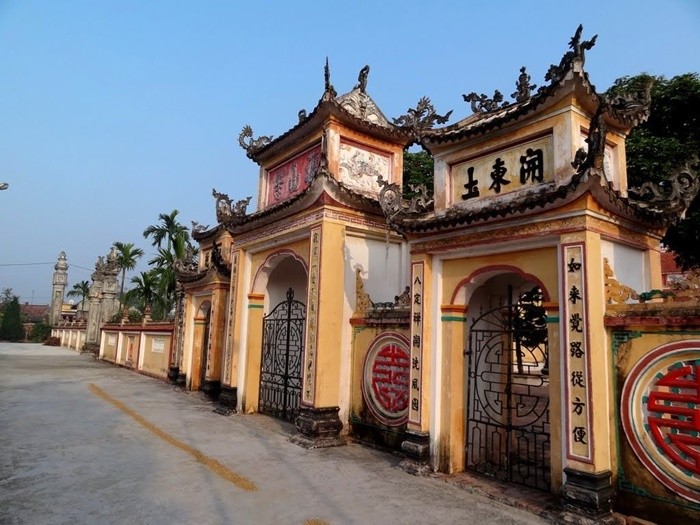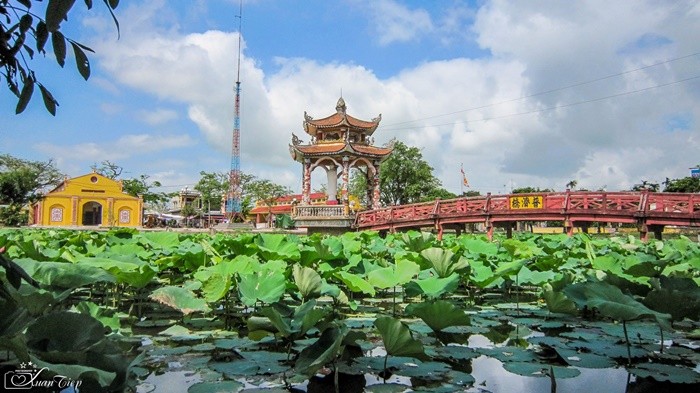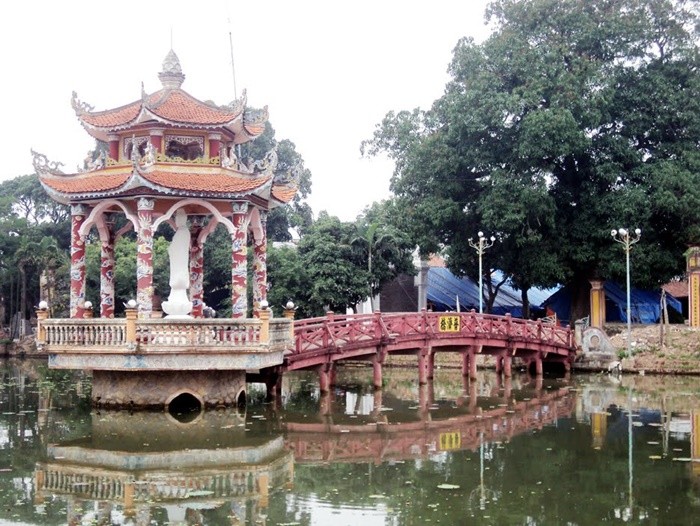TOP 6 spiritual tourist destinations in Nam Dinh for devotees
Throughout the year, the spiritual tourist spots in Nam Dinh attract many devout devotees to visit and
Considered a “hundred-room pagoda”, Luong Nam Dinh pagoda is an ideal stopover for tourists to visit the temple and admire its ancient and unique architecture.
Location: Belonging to Hai Anh commune – Hai Hau – Nam Dinh
Luong Pagoda – Tile Bridge – Phong Lac Communal House is a famous historical relic of Hai Hau hometown located in Hai Anh commune (this is the old Quan Anh land associated with the reclamation and encroachment of the sea more than 500 years ago. ). Experiencing many ups and downs in history – this ancient temple still retains its ancient beauty with unique and unique sculpture art.
Luong Nam Dinh pagoda and Tile bridge are two relics of Hai Anh commune today. Talking about the history of building the ancient temple in the 15th – 16th centuries. The name of the pagoda at that time was Phuc Lam pagoda or also known as the hundred compartment pagoda. The pagoda was built in the North of Luong market, so the people here call it Luong pagoda. When it was first built, the pagoda was roofed mainly by grass-roofing, then changed to tile roof.
After many times of restoration, construction and repair, Luong Hai Anh pagoda now has an increasingly large and perfect scale with 100 compartments including: Front hall; Upper power; Post-electricity; 2 East-West corridors; ancestral church; 2 back rooms; bell tower, guest house, three entrances, in front of the temple is a semicircular lake in summer when lotus blooms fragrantly, covered with green.
Today, Luong Pagoda has an extremely large scale and has the beauty of ethnic architecture from many different eras. But in general, the temple still retains its architectural beauty from the 17th and 18th centuries.
In terms of overall architecture, Luong Hai Anh Pagoda with the main area is clearly highlighted by the technical skill level with the sophisticated and sharp aesthetic that ancient folk artists created.
The entire frame of the temple’s construction items always ensures solidity, solidity with high sustainability. Through many years of history, the architecture of the temple still retains its elegant and gentle beauty.
High-level mortising and assembly techniques help construction parts to be closely linked and mortise without being shaken. This is the skill of the ancient artisans in perfecting and shaping the blades, pillars, duel, pliers, corns, ruongs, stilts, roof leaves, processing horizontal lines, corners…
The sculpture art of the temple is extremely unique. In each architectural element, especially in the forecourt buildings, which have been painted with textured lines, carved the image of a flying and soft dragon with a soulful posture, reaching the peak of art: dragon rolling water , dragons worship the moon, dragons hold pearls, dragons claw their beards; flying dragon, bamboo turns dragon; dragons and horses, birds and fishes playing… All these details have created a flexible and vivid picture, increasing the ancient beauty of Luong Pagoda. In particular, the image of a tiger is carved extremely charismatic and sensitive to increase the majesty and attraction of the temple.
Luong Nam Dinh Pagoda was built on an extremely beautiful and airy terrain. In front of the main pagoda is a spacious semi-circular lake with clear blue water and lotus plants. In summer, blooming lotus flowers show off their pure pink color in harmony with the high blue sky, bringing a peaceful beauty for visitors to enjoy.
The large semicircular lake is like a mirror reflecting the shadow of the three gates along with rows of tall green ancient trees that shade the pagoda. The temple campus is clearly demarcated into 2 areas and closely linked with each other.
With area 1 of the pagoda, including key and essential works of the pagoda, including 49 compartments: front hall, steeple, three treasures, back street, 2 rows of east-west corridors are closely and logically linked together. in the way of crossing roofs, rhyming to create a unique and harmonious architecture.
The main building materials for the pagoda wall and roof are Bat Trang square bricks and ta tiles. Prominent above all is the 5-room frontage with bold architectural beauty of the Late Le Dynasty from the 17th – 18th centuries. The overall architecture of Luong Nam Dinh pagoda does not grow in height, but in width and width, so the roof of the pagoda is soft and curved. The architectural structure of the temple is used in the style of traps, lines, first sentences, young pillars in harmony with each other.
Area 2 of Luong pagoda includes: Quan Am ancestral house; room increase; guest house; kitchen, warehouse… including 49 different large and small spaces with the characteristic of traditional ethnic architecture. The north of the pagoda consists of dozens of tomb towers associated with the overall architecture of the temple.
Visitors to Luong Pagoda will be impressed with the pearl well here because of its uniqueness. The well is built from stone mortars arranged in a large circle that are superimposed on each other. The well water is clear, cool and is often used by pagodas to make sticky rice dishes, to fix Buddhist rituals.
The Buddha statue in the temple is located at the bridge on the floor with a gentle, lively design, close to the people’s life. These statues are quite large in size such as: Adi Da statue; Bodhisattva statue; Guardian; The eight flavors of Diamond… all show and highlight the beauty of talented art and architecture. In particular, 3 statues of the Three Worlds; The temple, the statue of the enlightened ancestor and other statues all have special artistic value.
Currently, in the East and West corridors, it is the place to keep a large amount of valuable epitaphs. The total number of stele in the pagoda is up to nearly 40 stele divided into 2 blocks: “Square stele with statue, round stele attribution”. The content in the inscription is very rich: with the post-stele recording the contributions of the people at the temple; The inscription records the merits of enlightenment of the four ancestors through the repair and upgrading of the pagoda as well as the process of reclamation and encroachment on the sea.
Behind the West corridor is Phong Lac communal house – a place to worship the four ancestors as well as the martyrs who enlightened the homeland, clans, built temples. In particular, during the resistance war, Luong Nam Dinh pagoda was the revolutionary base. After the victory, the temple’s living room was used as a literacy classroom. In 1990, the pagoda was recognized as a national historical and cultural relic.
Since ancient times, Luong Nam Dinh pagoda has been a unique sightseeing destination of Thanh Nam land. For the children of Hai Hau, this is also the place to organize a special Luong pagoda festival in the third lunar month that attracts many local and faraway tourists to come here to attend.
And in the near future, if you have a trip to Nam Dinh , remember to visit the Tile Bridge – Luong Pagoda to better understand the history and culture here.
Photo: Internet




